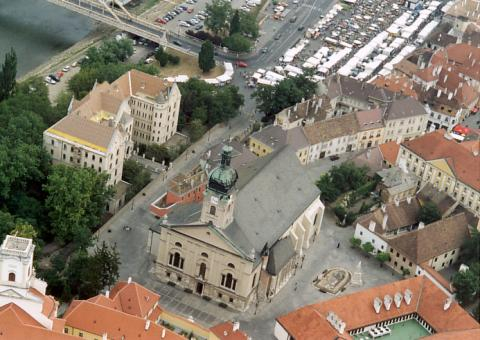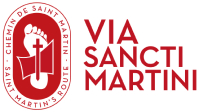
Point of interest- Győr - Cathedral of the Assumed into Heaven Blessed Virgin Mary (Basilica)

A győri Mennyekbe Fölvett Boldogságos Szűz Mária székesegyház a Győri egyházmegye főtemploma. A város legősibb részén, a Rába és a Duna összefolyásánál fekvő Káptalandombon áll, a Püspökvárral szemben, amely mellett a város legrégibb és legjelentősebb műemléke.
One of Hungary's most important national relics, the St. László hermitage, is kept here. In 1997, Pope John Paul II granted the cathedral the status of a minor basilica.
The east-facing three-nave basilica has a neoclassical façade with large semicircular windows, a tympanum on top, vases on the corners and a tower with a tufted helmet behind. The bronze gate of the main entrance was made in 1938 by Bandi Schima, a craftsman from Győr.
On the north and south sides of the basilica there are red marble doorways, made in 1774.
Gothic window frames are clearly visible between the Gothic pillars of the side aisles. A Gothic chapel, the Héderváry Chapel, is attached to the south side. On the west side, the original Romanesque apse of the cathedral can be seen.
The interior of the basilica, divided into three aisles by two colonnades, is an imposing sight. The interior layout reflects the 17th-century reconstruction. The rectangular columns contain Gothic pillars on which rest the drawer-shaped dome vaults of all three naves. Maulbertsch's ceiling painting of 1772 on the vault of the sanctuary depicts the Homage of the Hungarian Saints. On the wall of the six drawer vaults of the ceiling, the paintings depict Old and New Testament themes. The main altarpiece, framed by columns, was designed by Menyhért Hefele, while the altarpiece depicts the Assumption of Mary, a work by Maulbertsch. On either side of the high altar and in the openings above the stallums of the sanctuary are Baroque sculptures in gilded panels. On either side are canonical stalls with carved, gilded decoration, dating from the second half of the 18th century. The upholstery of the bishop's throne on the left was made for Maria Theresa and was bought by Bishop Zichy. Above it is a grisaille depicting the foundation of the cathedral, and on the opposite wall is a scene of St. Lazarus drowning. The fresco on the ceiling of the nave, depicting Christ changing colour, is Maulbertsch's largest work. At the ends of the marble railing separating the sanctuary from the nave are two black altars in relief. These are precious and rare works of art, excellent examples of Baroque art. The tasselled marble pulpit has an ornate ramp and a baroque sound box. The nave is lined with beautifully carved Rococo oak benches. The interior is harmoniously completed by the choir, its organ case framed with gilt carvings and decorated with angels.
The main attraction in the north aisle is the image of the Virgin Mary weeping tears of blood, brought from Ireland in 1655. To the right of the sanctuary are two side altars, to St Anne and the Three Kings. Behind the current closing wall of the sanctuary is the Romanesque apse with its period mural.
One of the two magnificent ceiling paintings in the southern side aisle is by Maulbertsch, the other probably by one of his pupils. The altars were designed by Menyhért Hefele. The main altar with its columnar construction, depicting the stoning of St Stephen the Martyr, is probably the work of Paul Troger. The two side altars on the left are to St Joseph and the Virgin of Sorrows. The Maulbertsch painting on the south wall of the sanctuary depicts Christ on the cross. There is also an artistically decorated baptismal font. The nave is adorned with stencil paintings by Eszter Mattioni.
From the south aisle you can reach the Gothic Héderváry Chapel, built in 1404. The coloured windows were made by Lili Sztéhlo Árkainé. The most precious masterpiece of our country's jewellery art, the St. László Fountain, is kept here. The gilded silver headpiece was made by master Dénes during the reign of Béla III. The herm was restored in the 14th century, when the old breastpiece was enlarged and turned into a twisted enamel. In 1600, the present neck was made in Prague, where the neck ring was fitted as a reinforcement. The original four-pointed Gothic crown was also made into the present ten-pointed crown, decorated with Czech garnets, colourless quartz and glass. The silver horn hanging around the neck of the herm dates from the 15th century. The Héderváry Chapel also houses the tomb of Vilmos Apor, the martyred bishop of Győr, by sculptor Sándor Boldogfai Farkas and painter Eszter Mattioni.
Two vestries are attached to the north side of the cathedral. Among the seemingly simple furnishings of the outer sacristy are several valuable pieces. The inner sacristy belongs to the canons and its carved gilt furniture dates from the second half of the 18th century. Here is the basilica treasury, whose most valuable items are: chalices decorated with 15th century chasuble enamel, medieval sacramental books, a silver-bound prayer book of Ferenc Rákóczi II, a 14th century prayer book of the Holy Father, a 14th century prayer book of the Holy Father, and a 14th century prayer book of the Holy Father. A 15th century ivory triptych wing, a 1550s chasuble of the Transylvanian bishop Pál Bornemissza, decorated with pearls and precious stones, a 15th century Florentine vestment donated by King Matthias. Outside the northern wall of the cathedral are masonry Romanesque stones, and the famous Victoria altar is built into the pillar east of the northern entrance. Above it is a bronze relief depicting the history of the cathedral, with the date 1466 engraved below, marking the beginning of the Gothic rebuilding of the church.
- Győr - Mennyekbe Felvett Boldogságos Szűz Mária székesegyház (Bazilika)
